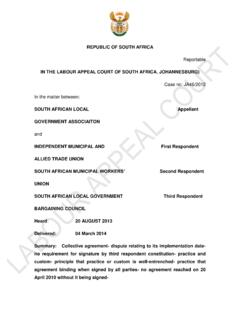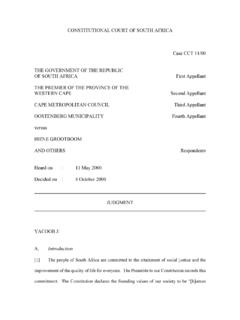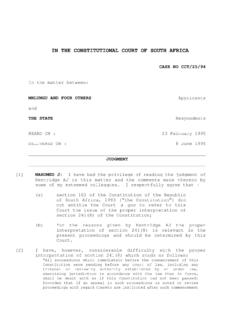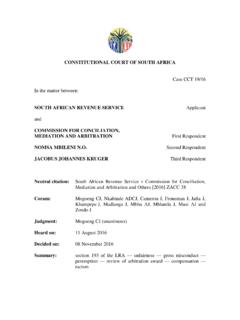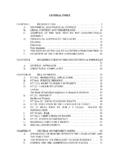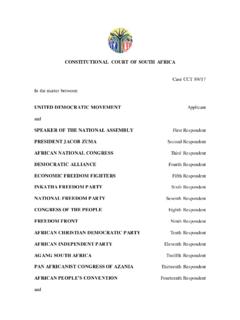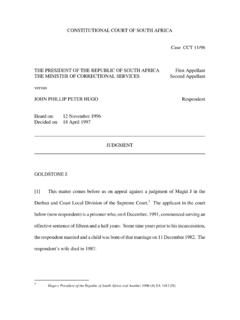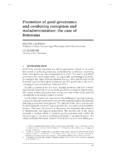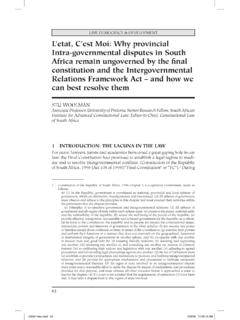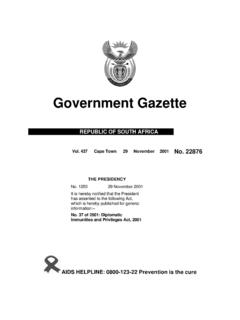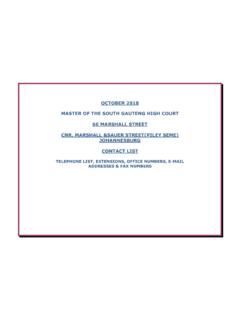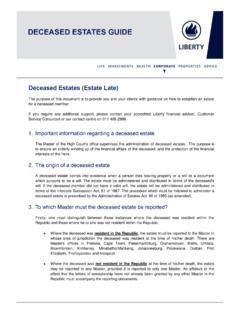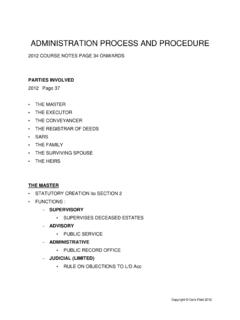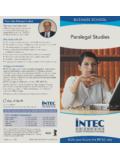Transcription of THE HIGH COURT OF SOUTH AFRICA GAUTENG …
1 THE high COURT OF SOUTH AFRICA GAUTENG division , pretoria opposed motion JOHANNESBURGCASE NO: 15/98694 DATE: 15/98694In the matter between:U. J. E. (BORN R.) ApplicantandI. J. U. First RespondentE. K. T. I. Second RespondentJ. U. NO Third RespondentJ. J. E. NO Fourth RespondentE. T. (PTY) LIMITED Fifth RespondentREPRESENTED BY MATHYS JOHANNES VAN DEN BERG NOJUDGMENTMAKUME,J:[1] This is an application in terms of Rule 10 (3) of the Uniform Rules of COURT in which the Applicant seeks an order to join the E.
2 K. T. (the Trust), its trustees as well as E. T. (Pty) Ltd represented by one Mathys Johannes Van den Berg as second to fifth Defendants in an action between the Applicant and the First Respondent (the divorce proceedings)The Applicant also seeks an order to amend the particulars of claim in her divorce proceedings to include second to fifth Respondents as second, third, fourth and fifth SAFLII Note: Certain personal/private details of parties or witnesses have been redacted from this documentin compliance with the law and SAFLII PolicyDefendants[2] The Applicant and the first Respondent are spouses married out of community of property with the application of the Accrual System in terms of chapter 1 of the Marriage Property Act 88 of 1984.[3] During or about December 2015 the Applicant issued summons against the first Respondent in which she seeks dissolution of their marriage and an order that the first Respondent pay to her an amount equal to half of the difference between the accrual of their respective estates (the divorce proceedings).
3 [4] During or about April 2002 the Trust (Second Respondent) was registered at the instance of the first Respondent. First Applicant and Second Respondent are the trustees of the trust their two children C. J. U. and J. J. E. were nominated as beneficiaries.[5] The basis on which the Applicant seeks to join the trust and its trustees in the divorce proceedings is with the intention to obtain the following That the assets of the trust be included in the assets or estate of the Alternatively to above that a declaratory order be granted that the assets ostensibly held by the trust are or were in fact the first Respondents assets and should be added to the first Respondent estate for purposes of calculating accrual in terms of Section 3 ,md 4 of the Matrimonial Property Act 88 of Alternatively to above that an order be issued to the effect that transactions reflecting the E.
4 K. T. (The Trust) as acquiring and holding assets were simulated and that actually these assets were and are part of the first Respondent's assets.[6] According to the Applicants the Trust property consists of farmland with livestock and improvements estimated to be valued at about R4 million. This value is disputed by the first Respondent.[7] In the notice of amendment to the Applicants particulars of claim in the divorce proceedings the Applicant maintains that she will present evidence to prove that the trust assets held ostensibly by the second Respondent must be added to the net value of the first Respondents personal estate at the time of the dissolution of the marriage for purposes of calculating the accrual of the first Respondents estate in terms of Section 3 and 4 of the Marriage Property Act 1984.[8] At the heart of this application is the Applicant's contention that the asset of the Elandskloof Kinder Trust are not only de facto but also dejure part of the assets of the first Respondent.
5 Evidence to substantiate the Applicants contention will be presented to the trial COURT in the divorce proceedings not in this application. Indeed that was the approach of Leverson Jin K & S Dry Cleaning Equipment v SOUTH African Eagle Insurance 1998(4) SA 456 at 482 B where in describing the purpose and aim of Rule 10(3) said the following:Our Rule permits the joinder of parties in the same proceedings but it does not direct the hearing of evidence as between all defendants, so that the extent of liability is determined between all parties and particularly not where no vestige of determination of such issue is incumbent on the COURT merely on the averment of thePlaintiff. [9] In opposing this application the first and third Respondents raised the following issues in the answering affidavit some of which were not followed up in the Respondents head of argument.
6 The Respondents argue The amendment sought by the Applicant is vague and embarrassing in that Applicant has failed to specify the assets and transactions in respect whereof the Applicant intends to claim the relief of Secondly that the proposed amendments to the particulars of claim was not annexed to the application to enable the Respondents to consider the regularity and admissibility That the proposed amendment if granted would be That the Applicant should have cited the Master of high COURT as a party and served the application on the Master's That the Applicant has failed to join the two children of the marriage being the beneficiaries of the Elandskloof Kinder Trust as they have vested interest and t'1e relief sought could materially be prejidicial to their That similarly failure to join one Elsie Susan Uys who is a usufructuary ofthe farm which is registered in the name of the trust rendered this application unsuitable for a decision until she shall have been joined.
7 She has material interest in the proceedings. It is argued by the Respondents that the relief will infringe on her right as the THE INTENDED As I indicated earlier on this issue is not dealt with by the Respondent in their original as well as in their amplified heads of argument. 1 here was no indication that the Respondent have now abandoned that In any case the complaint that the intended amendment is vague and embarrassing for failure to specify the assets has been cured. In the Replying Affidavit the intended amendment has been fully set out. It must be remembered that such amendment still has to be dealt with in accordance with Rule 28 of the Uniform Rules of COURT . There is a procedure to be followed one, the Rule 28 notice has ben served. The objection if any in my view is not only misplaced it is also premature.
8 [11] FAILURE TO CITE/JOIN THE This is in my view a technical defence which does not affect the validity procedural or otherwise of the Applicants case. In any case the joinder application was serv1 d on the Master on the 1st February 2017. The Master's office plays a regulatory role and has no interest in any dispute between the parties. Accordinglythis defence falls to be dismissed.[12] FAILURE TO JOIN THE This seem to be the main objection and defence to thisapplication. The Respondents dealt with this aspect extensively in both the main and the amplified heads of The Respondents argue that because the two children, C. J. U. and J. J. E. are adults they should be joined simply because they have vested right in the it is not in dispute that the two beneficiaries have vested interest in the trust what is an issue is whether they should be joined as dependants in a divorce case involving their A beneficiaries basic right is that of insisting on the proper administration of the trust so that he or she can enjoy the benefits to which he or she is actually on potentially entitled to under the trust.
9 In Gross and Others vs Pentz 1996 (4) SA 617 the COURT reiterated the general rule that trustees not beneficiaries have locus standi to act in legal proceedings on behalf of the trust it was however held that the general rule does not apply in the event where a beneficiary instituted actin in his or her own right against the trustee for In this matter there is no reason why the beneficiary should be cited as there is no allegation of the trust being maladministered. The right if any of the beneficiaries remain as set out in the deed of In my view this defence has no merits and should be dismissed the trust is sufficiently represented by its trustees who have not at this stage been accused of any maladministration of the trust fund or FAILURE TO JOIN AND SERVE ON E. U. THE It is common cause that Mrs E. S. U. Id Number: [.]
10 ] is a usufructuary on the farm held in thename of the E. K. The Respondents argued that the relief claimed by the Applicants will infringe on her rights and therefore she should have been cited as a party to the A usufruct is personal right and does not form part of ones estate. That personal right confers only use and enjoyment during the life time of the There is no indication or threat that if \he application is eventually successful! in proving that the farm shall fall into the estate of the First Respondent that this will in anyway affect the right of use and enjoyment of E. S. U. over the farm. Her rights remain In any case Mrs Elsie Uys was served with all the documents the Notice of motion and the intended amendment and was invited to join the proceedings if she so wishes she has not done so. The first Respondent has no mandate or authority to speak on her behalf.
